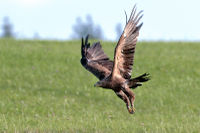Clanga (Birds)
 From Conservapedia
From Conservapedia | Genus Clanga | |
|---|---|

| |
| Lesser spotted eagle Clanga pomarina | |
| Scientific classification | |
| Kingdom Information | |
| Domain | Eukaryota |
| Kingdom | Animalia |
| Subkingdom | Bilateria |
| Branch | Deuterostomia |
| Phylum Information | |
| Phylum | Chordata |
| Sub-phylum | Vertebrata |
| Infraphylum | Gnathostomata |
| Class Information | |
| Superclass | Tetrapoda |
| Class | Aves |
| Sub-class | Neornithes |
| Infra-class | Neoaves |
| Order Information | |
| Order | Accipitriformes |
| Sub-order | Accipitres |
| Family Information | |
| Superfamily | Accipitroidea |
| Family | Accipitridae |
| Sub-family | Aquilinae |
| Genus Information | |
| Genus | Clanga |
| Species Information | |
| Synonyms | Aquila |
| Population statistics | |
Clanga is a genus of birds of prey of the family Accipitridae, consisting of three species of eagle found in Eurasia and Africa, and commonly referred to as "spotted eagles".
Contents
- 1 Description
- 1.1 Species
- 2 Threats
- 3 References
Description[edit]
Spotted eagles are medium-sized, about 23–28 inches in length, a wingspan of 61.8 to 70.5 inches, and weigh 3.5 to 5.5 pounds. Females are larger than males. They are medium to dark brown in color, with upper wing coverts and secondary flight feathers tipped in white, giving the birds a pair of white bands when the wings are folded. The upper tail covert is marked by a "V"-shaped white band. The underside is lighter in color, with both back and belly marked by small, light-colored or whitish marks, hence the name.
Species[edit]
- Greater spotted eagle, Clanga clanga
- Indian spotted eagle, Clanga hastata
- Lesser spotted eagle, Clanga pomarina
In the mid-2000s it was determined that a so-called "sister relationship" had been occurring between C. pomarina and C. clanga, which, as of 2005[1] made them distinctive genetically from other species of genus Aquila (true eagles), in which they had been previously placed. Further studies among diurnal raptors led to a revision of Aquila, resulting in the split of spotted eagles into their own separate genus, Clanga[2], a name taken from the ancient Greek word κλαγγή, ("clang" or "scream")[3], and refers to the piercing cries the birds make[4][5].
Threats[edit]
The greater spotted eagle has been classified as "vulnerable" by the ICUN[6], with no more than 8,800 mature individuals[7] within their breeding range. Reasons cited are habitat loss[8], persecution, and accidental poisoning throughout both breeding and winter ranges[9], as well as recently-discovered evidence of hybridization between it and the more common lesser spotted eagle[10]
References[edit]
- ↑ http://www-personal.umich.edu/~hlerner/LM2005.pdf
- ↑ https://books.google.com/books?id=DzmOUBbTbngC&pg=PA40&lpg=PA40&dq=Lerner+and+Mindell+spotted+eagles&source=bl&ots=5YcbgvGNSz&sig=ACfU3U0I8zZUgI5wXUivqH2uiEzageLRcQ&hl=en&sa=X&ved=2ahUKEwjx4_ao7PjnAhUODKwKHSy_DJYQ6AEwA3oECAkQAQ#v=onepage&q=Lerner and Mindell spotted eagles&f=false
- ↑ http://www.perseus.tufts.edu/hopper/text?doc=Perseus:text:1999.04.0057:entry=klaggh/
- ↑ https://www.xeno-canto.org/species/Clanga-clanga
- ↑ https://www.xeno-canto.org/species/Clanga-pomarina
- ↑ https://www.iucnredlist.org/species/22696027/110443604
- ↑ https://www.iucnredlist.org/species/22696027/110443604#population
- ↑ https://www.cambridge.org/core/journals/bird-conservation-international/article/importance-of-wetlands-for-the-greater-spotted-eagle-clanga-clanga-wintering-in-the-mediterranean-basin/D2424A6B9D50F57750DD8118B8FA1B57
- ↑ https://www.iucnredlist.org/species/22696027/110443604#threats
- ↑ https://www.researchgate.net/publication/262115655_Identification_of_juvenile_Greater_Spotted_Eagle_Lesser_Spotted_Eagle_and_hybrids
Categories: [Birds] [Birds of Prey] [Eagles]
↧ Download as ZWI file | Last modified: 02/15/2023 12:56:43 | 47 views
☰ Source: https://www.conservapedia.com/Clanga_(birds) | License: CC BY-SA 3.0
 ZWI signed:
ZWI signed: KSF
KSF